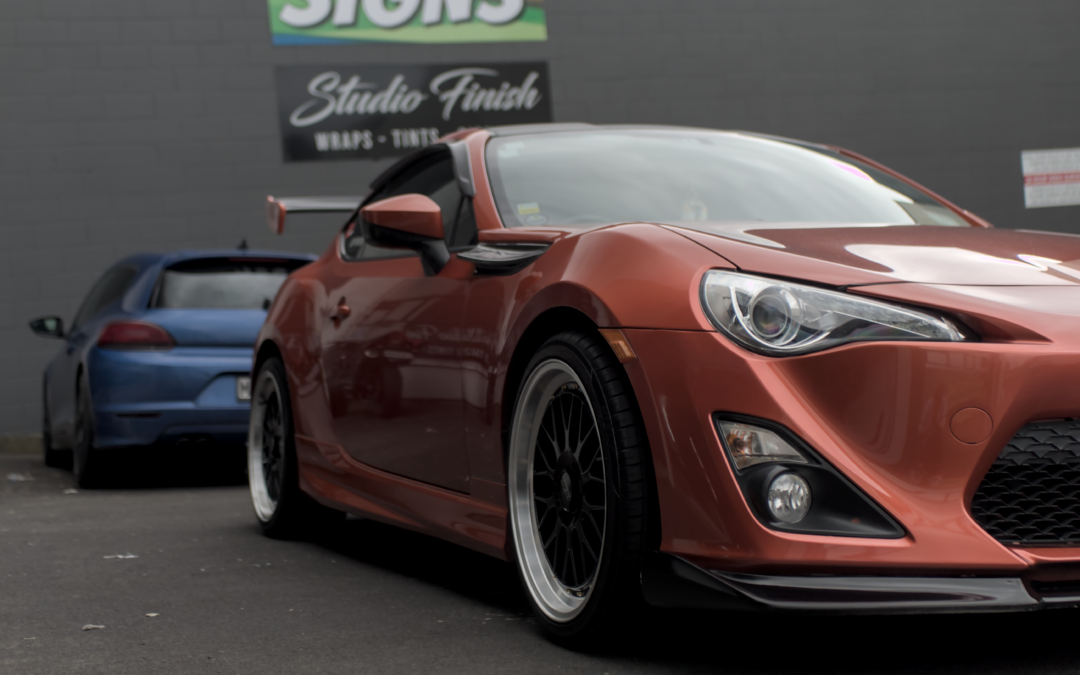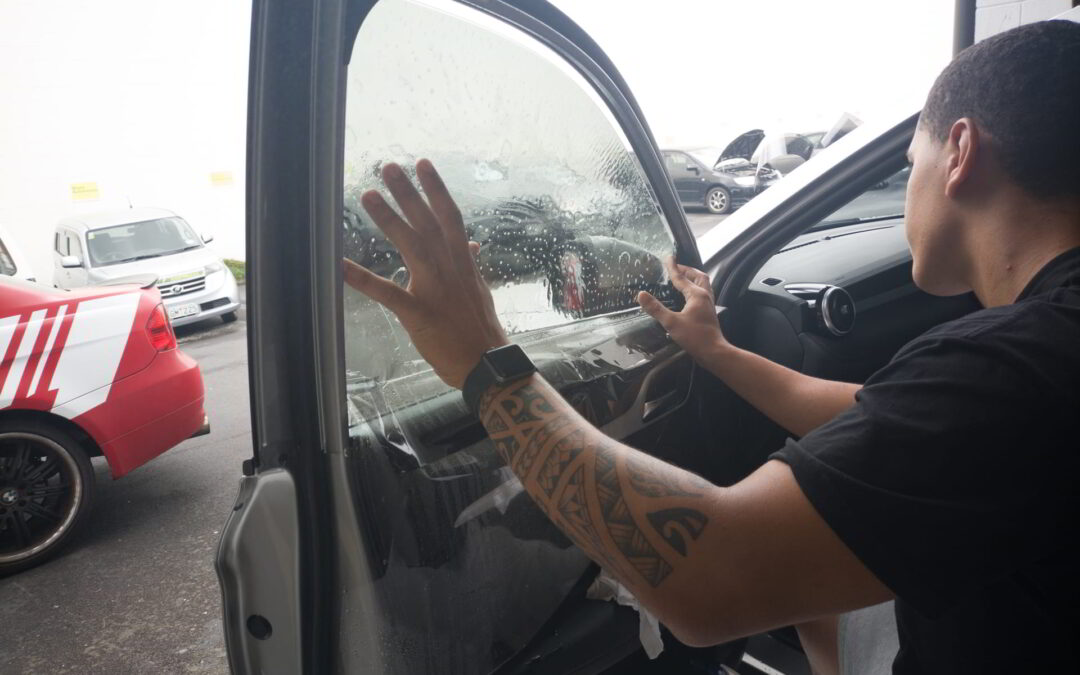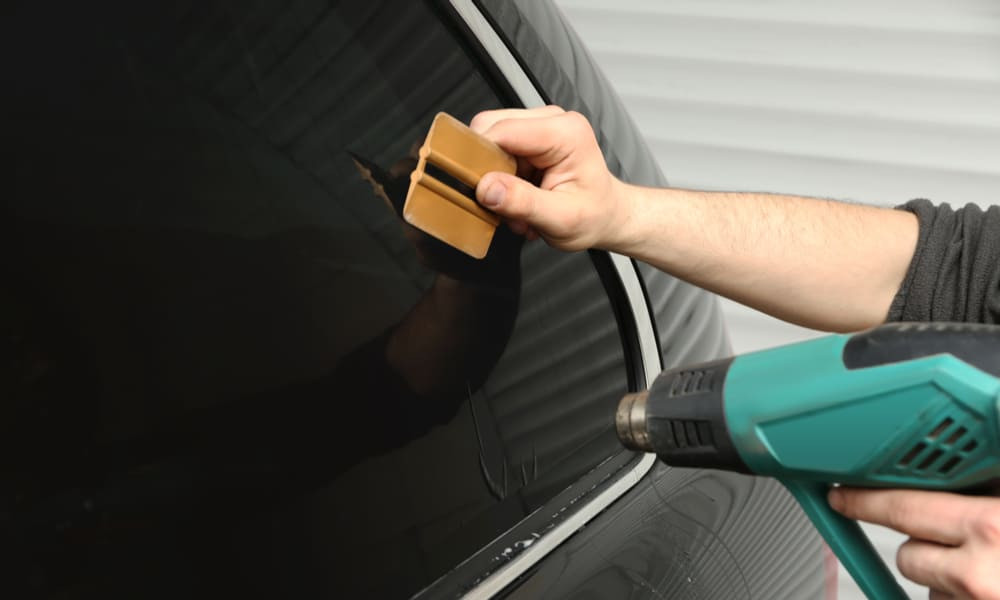The cost of window tinting for cars varies depending on the type of car and the size of the windows. Generally, it can range from $300 to $600 or more for a full job. The cost also depends on the type of tint chosen and the quality of materials used. Professional installation is recommended for better results and longer lasting protection against UV rays. Prices may
What is car tint?
Car tint refers to a thin layer of film that is applied to the windows of a vehicle. It is designed to block or filter out certain levels of light and heat from entering the interior of the car. Car tints come in various shades and levels of darkness, providing different degrees of privacy, UV protection, and heat reduction. Tinted windows can provide numerous benefits for both the driver and passengers, including reducing glare, protecting upholstery and interior surfaces from sun damage, improving energy efficiency, and enhancing the overall appearance of the vehicle. Additionally, car tint can also enhance safety by increasing shatter resistance in the event of an accident. It is important to note that car tinting laws and regulations vary from country to country, and it is essential to comply with local regulations to avoid potential fines or penalties.
What are the benefits of car tint?
Car tinting offers a range of benefits for vehicle owners in New Zealand. One of the key advantages of car tint is enhanced privacy. Tinted windows provide a level of privacy by making it more difficult for passersby to see inside the vehicle. This is especially beneficial for individuals who keep valuables in their cars.
Reduced glare is another advantage of car tint. Tinted windows help to reduce the amount of sunlight that enters the vehicle, minimizing glare and making for a more comfortable driving experience. This can be particularly helpful during sunny days or for individuals with sensitive eyes.
In addition to reducing glare, car tinting provides increased UV protection. The harmful UV rays from the sun can cause damage to the skin and eyes, and with car tint, these risks are significantly reduced. This is especially important in New Zealand, where the high levels of UV radiation contribute to the country’s high rates of skin cancer.
Car tinting also improves comfort by regulating the temperature inside the vehicle. Tinted windows help to block out a significant amount of heat, keeping the interior cooler and reducing the need for excessive air conditioning. This, in turn, leads to better fuel efficiency.
Lastly, car tinting enhances the aesthetic appeal of the vehicle. It gives a sleek and sophisticated look to cars of all makes and models, from station wagons to sports cars. With a wide range of options available, car owners can choose the darkness and style of tint that best suits their preferences and vehicle type.
Overall, car tinting in New Zealand offers enhanced privacy, reduced glare, increased UV protection, improved comfort, and an upgraded aesthetic appeal. With these benefits in mind, it is no wonder that car tinting is becoming increasingly popular among vehicle owners.
Cost Factors
Cost Factors for Car Tinting in New Zealand
When considering car tinting options in New Zealand, there are several factors that can influence the cost. The size of the vehicle and the number of windows to be tinted play a significant role in determining the overall cost. Larger vehicles, such as SUVs or passenger vans, with more windows to be tinted, may require more materials and labor, resulting in higher costs. The type and quality of tinting film chosen can also affect the price. Standard tints are generally more affordable, while ceramic films, known for their superior heat and UV blocking capabilities, tend to be more expensive. The darkness or level of tint desired can also impact the cost, as darker shades may require additional layers of film. Moreover, the reputation and expertise of the tinting service provider can influence the price. Opting for a professional and experienced company may result in higher costs but can ensure a quality installation without defects or damage. By considering these cost factors, car owners can make informed decisions and find the right balance between their budget and the desired benefits of car tinting.
Type of Tint
Car tinting refers to the process of applying a thin, transparent film to the windows of a vehicle. In New Zealand, there are various types of car tint available to meet different needs and preferences. Each type offers unique characteristics and benefits.
Dyed films are the most common and affordable option. They block sunlight and reduce glare, providing a cooler and more comfortable interior. These films also offer some level of UV protection.
Metallic films are similar to dyed films but contain metalized particles that enhance their heat rejection properties. They provide superior heat and glare reduction, making them ideal for hot climates and sunny conditions.
Carbon films are known for their excellent UV protection and heat rejection capabilities. They do not interfere with the functioning of electronic devices and have a high level of visible light transmittance, ensuring good visibility for the driver.
Ceramic films are advanced and offer the highest level of heat rejection without interfering with electronic signals. They provide excellent UV protection, reduce glare, and maintain great visibility.
Crystalline films are the pinnacle of window tint technology. They offer extreme heat rejection while still providing maximum visibility with a clear appearance. These films are pricey but provide the ultimate driving experience.
When selecting the right type of tint film for your vehicle, consider factors such as heat rejection, UV protection, visibility, and your specific needs and preferences. Consulting with a professional window tinting service can help you choose the best option for your car.
Size of Vehicle Windows
When it comes to the cost of car tinting, the size of your vehicle windows plays a crucial role. Different window sizes may require varying amounts of tinting film, which can result in different costs. Larger windows, such as rear windshields, often incur higher expenses due to the need for more materials and labor.
The size of your vehicle windows directly impacts the amount of tinting film needed to cover them. Smaller windows require less film, which can contribute to lower costs. On the other hand, larger windows, especially rear windshields, may necessitate more film, leading to higher expenses.
Not only do larger windows require more materials, but they also require additional labor. Tinting technicians need to carefully apply the film to cover the entire surface area of these windows, which can be more time-consuming and complex.
When considering the cost of car tinting, it is essential to factor in the size of your vehicle windows. Larger windows, particularly rear windshields, may incur higher expenses due to the increased amount of tinting film and labor required. Consulting with a professional tinting service can help you determine the exact cost based on your specific vehicle and window sizes.
Number of Windows to be Tinted
The number of windows to be tinted depends on the size and type of vehicle. Smaller vehicles such as sedans and hatchbacks usually have a standard set of windows to be tinted, which includes the front and rear side windows and the rear windshield. These vehicles typically have four windows in total.
However, larger vehicles like SUVs, vans, and station wagons often have additional windows to be tinted. In addition to the standard set, larger vehicles may have rear side windows and even extra windows, such as those found in passenger vans. Therefore, the number of windows to be tinted can vary greatly depending on the size and style of the vehicle.
Tinting all windows can provide increased privacy and security, especially for larger vehicles like vans. It prevents prying eyes from easily seeing the contents of the vehicle, making it less attractive to potential thieves. Additionally, tinted windows reduce the likelihood of smash-and-grab attacks, as they make it more difficult for would-be thieves to see inside and assess the value of items left in the vehicle.
Tinting rear windows, side windows, and even the windshield provides optimal UV protection and reduces glare. Window tinting helps block harmful UV rays, protecting the vehicle’s interior from fading and reducing the risk of skin damage. It also reduces glare from the sun, making driving safer and more comfortable.
In conclusion, the number of windows to be tinted depends on the size and type of vehicle. Tinting all windows can offer increased privacy and security, while also providing UV protection and reducing glare.
Quality of Window Film
The quality of window film is determined by several key factors. One important factor is whether the film comes with a manufacturer’s warranty. A warranty provides assurance that the film is of a certain standard and will perform as expected.
Another factor is the clarity of the glass after the film is installed. High-quality films should have excellent optical clarity, allowing for clear visibility both during the day and at night. Poor-quality films can distort the view through the windows, which can potentially impact the driver’s visibility and overall safety.
Allowable modifications are also an important consideration. Some window films may allow for tinted overlays, which can enhance privacy and improve aesthetics. However, it’s essential to ensure that any modifications comply with legal restrictions.
Speaking of legality, it’s important to understand the legal restrictions on window film overlays. Different regions or countries may have specific laws regarding the darkness of window tints. These laws are in place to balance road safety and vehicle customization. Adhering to these regulations is crucial to avoid potential fines and ensure the safe operation of the vehicle.
In summary, the quality of window film is determined by factors such as a manufacturer’s warranty, the clarity of the glass, and the allowable modifications. It is important to choose high-quality films that provide clear visibility and comply with legal restrictions for a safe and enjoyable driving experience.
Installation Process and Labour Costs
The installation process of car tint involves several steps, and the associated labor costs can vary depending on the size of the vehicle and the number of windows to be tinted.
Firstly, the windows need to be cleaned thoroughly to ensure a smooth surface for the tint to adhere to. Any debris or dirt can affect the quality of the installation.
Next, the window tint film is carefully measured and cut to fit the specific dimensions of each window. This requires precision and expertise to ensure an accurate fit.
Once the film is cut, it is carefully applied to the inside of the windows. A professional installer will make sure to eliminate any wrinkles or air bubbles to ensure a seamless appearance.
The labor costs associated with car tint installation typically include the time and expertise of the installer. Pricing can vary depending on the size of the vehicle and the number of windows to be tinted. Larger vehicles with more windows may require more labor and subsequently incur higher costs.
It is advisable to consult with a reputable car tinting service to get an accurate quote for labor costs based on your specific vehicle and window requirements.
Legal Limitations in New Zealand on Window Tints
Window tinting in New Zealand is subject to certain legal limitations to ensure the safety of road users. The New Zealand Transport Agency (NZTA) has established regulations regarding the use of tinted windows on vehicles. These regulations dictate the level of darkness that window tints can have, measured through light transmittance or visible light transmission (VLT). The current legal limit for VLT on the front side windows and windshields is 35%, meaning that at least 35% of visible light must pass through the tint. Rear side windows and rear windows have a legal limit of 35% or a darker shade, but it is important to note that these tint percentages are not cumulative. Furthermore, the use of reflective tints is strictly prohibited. It is crucial for vehicle owners to adhere to these legal limitations to avoid any penalties or fines. Additionally, it is recommended to consult with a professional tinting service to ensure compliance with the window tint laws in New Zealand.
Visible Light Transmittance (VLT) Requirements for Passenger Vehicles and Vans in NZ
In New Zealand, there are specific regulations regarding the Visible Light Transmittance (VLT) requirements for passenger vehicles and vans. These requirements dictate the level of darkness on vehicle windows, ensuring safety and compliance with the law.
For passenger vehicles, the front windscreen and front side windows must have a minimum VLT of 35%. This means that at least 35% of visible light must be allowed to pass through these windows. However, the rear side windows and rear windscreen can have a darker shade, with no specific VLT requirement.
On the other hand, vans have slightly different VLT requirements. The front windscreen must also have a minimum VLT of 35%. However, all other windows on vans, including the front side, rear side, and rear windscreen, must have a minimum VLT of 20%. This allows for slightly less visible light to pass through these windows compared to passenger vehicles.
To ensure compliance with these regulations, glazing markings window film is often used. This film is applied to the vehicle windows and contains markings that indicate the VLT percentage. This helps both drivers and law enforcement officers easily identify if the VLT requirements are being met.
Adhering to these VLT requirements not only ensures that vehicles comply with the law, but also maintains safety on the roads for all road users. Having the correct level of tint on windows helps reduce glare, provides UV protection, and enhances the driving experience, while still allowing enough visibility for the driver.
Remember to consult with a professional tinting service provider to ensure the correct application of window film to meet the VLT requirements for passenger vehicles and vans in New Zealand.
Sun Visors, Rear View Mirrors, Windshields, and Other Considerations
Sun visors play a crucial role in blocking direct sunlight and reducing glare while driving. However, it’s important to note that applying tint directly on sun visors is not advisable. The purpose of sun visors is to provide clear and unobstructed visibility, and adding tint to them can hinder their functionality.
Rear view mirrors also require careful consideration when it comes to car tinting. The rear view mirror should remain unaffected by the tint, as it needs to provide a clear reflection of the rear of the vehicle. Tinting the windshield may affect the quality of the reflection, making it difficult to see other vehicles behind.
When it comes to windshields, New Zealand regulations prohibit tinting on the front windscreen, except for a narrow strip along the top. This strip, commonly known as a sun visor band, must be no more than 10 centimeters in width and not extend below the AS1 line marked on the glass.
In terms of legal requirements, rear-view mirrors must remain unobstructed and positioned appropriately to provide a clear view of the road. Any modifications or accessories, such as radio antennas or electrically-heated demister units, should not compromise the effectiveness of the mirrors.
Glazing markings, which indicate the Visible Light Transmission (VLT) percentage, are often used on window film to ensure compliance with legal requirements. It is essential to choose a tint installer who uses glazing markings window film to guarantee adherence to VLT regulations while maintaining visibility and safety on the road.
In conclusion, it is crucial to consider the functionality of sun visors, rear view mirrors, and windshields when tinting car windows. Adhering to legal requirements for rear-view mirrors and vehicle windows, along with using glazing markings, will ensure compliance with regulations and maintain a clear view for safe driving.
Types of Car Tinting Products Available in New Zealand
When it comes to car tinting, there are various types of products available in New Zealand that cater to different needs and preferences. One popular option is standard tints, which offer UV protection and privacy while allowing for a moderate level of light transmission. Another option is ceramic films, which provide excellent heat rejection and UV protection without interfering with electronic devices inside the vehicle. Tinted films are also commonly used, offering a darker shade and enhanced privacy. For those looking for the ultimate privacy and maximum heat rejection, there are high-performance tints available that provide superior heat reduction and optimal light transmittance. Additionally, there are specialized tints designed for specific vehicle types such as sports cars, station wagons, and larger vehicles. With a wide range of options available, car owners can choose a quality tint that suits their preferences and maximizes their driving experience while adhering to New Zealand’s window tinting laws.
Ceramic Films
Ceramic Films are a popular choice for car tinting due to their superior features and benefits. One notable advantage of Ceramic Films is their exceptional heat rejection properties. These films can effectively block out a significant amount of heat, helping to keep the interior of your vehicle cooler even on hot summer days. This not only enhances driving comfort but also reduces the need for over-reliance on air conditioning, resulting in potential fuel savings for the vehicle owner.
In addition to heat rejection, Ceramic Films also offer superior UV protection. These films are designed to block harmful UV rays, shielding both the driver and passengers from the damaging effects of the sun. UV protection is not only important for skin health but also helps in preserving the interior of the vehicle, preventing fading and cracking of upholstery, dashboards, and other surfaces.
Furthermore, Ceramic Films have reduced glare properties, making them an excellent choice for enhancing visibility while driving. Glare can be a major distraction and hazard on the road, especially during bright and sunny conditions. With Ceramic Films, the intensity of light entering the vehicle is reduced, minimizing glare and ensuring a safer driving experience.
Another key advantage of Ceramic Films is their durability and long-lasting nature. Unlike some other types of tint films, Ceramic Films are resistant to fading, bubbling, and peeling. They are designed to withstand prolonged exposure to sunlight and maintain their effectiveness over time.
Overall, Ceramic Films offer a wide range of benefits, including superior heat rejection, UV protection, reduced glare, and long-lasting performance. Investing in high-quality Ceramic Films can not only improve your driving experience but also protect your vehicle and its occupants from the harmful effects of the sun.
Carbon Films
When it comes to car tinting in New Zealand, carbon films are a popular choice among vehicle owners. These films are known for their exceptional heat rejection and UV protection properties, providing a comfortable and safe driving experience.
Carbon films are available in a range of shades and darkness levels, allowing individuals to choose the level of tint that suits their preferences and needs. These films effectively block out harmful UV rays, helping to prevent sun damage to both the vehicle’s interior and the driver and passengers.
One of the key benefits of carbon films is their ability to provide excellent heat rejection, keeping the interior of the car cool even on hot summer days. This not only enhances comfort but also reduces the need for excessive air conditioning, resulting in fuel savings.
Despite their superior heat rejection and UV protection capabilities, carbon films offer good visibility both during the day and at night. They do not interfere with the driver’s vision, ensuring optimal safety on the road.
When considering car tinting options, carbon films emerge as a top choice due to their ability to provide superior heat rejection and UV protection while maintaining good visibility. Invest in these high-quality products to enhance both the comfort and safety of your driving experience.
Metal Films
Metal films are another popular option for car tinting in New Zealand. These films contain tiny metal particles that are embedded within the film, giving the windows a reflective appearance.
One of the main characteristics of metal films is their ability to provide excellent heat rejection. The metal particles in the film reflect a significant amount of the sun’s heat, helping to keep the car’s interior cooler. This is particularly beneficial during hot summer days, as it reduces the reliance on air conditioning, ultimately improving fuel efficiency.
Metal films also offer superior UV protection. The metal particles in the film block harmful UV rays, which can cause damage to the car’s interior and even to the occupants’ skin. This helps to prevent fading, cracking, and discoloration of the car’s upholstery and also reduces the risk of skin cancer.
However, metal films can affect visibility to some extent. The reflective nature of these films can create glare, especially when driving at night or in bright sunlight. This can potentially reduce the driver’s visibility and compromise road safety. Additionally, metal films may interfere with electronic devices such as GPS or mobile phone signals.
Popular Brands of Window tint
When it comes to window tint for your car in New Zealand, there are several popular brands to choose from. However, three of the most trusted and highly recommended brands are STEK, 3M, and Lumar.
Choosing a quality window tint is important for several reasons. Firstly, a quality tint provides superior UV protection, blocking harmful rays from the sun and reducing the risk of skin damage and interior fading. It also helps to keep the interior of your car cooler, especially on those hot summer days.
Another reason to choose a quality tint is that it lasts longer. Cheap and inferior tint options may fade or peel over time, which not only affects the overall appearance of your vehicle, but also reduces the effectiveness of the tint.
STEK, 3M, and Lumar are known for their commitment to producing high-quality window films. They offer a wide range of options to suit different vehicles and preferences, including different levels of darkness, shades, and even ceramic films for maximum heat rejection.
While the initial investment in a quality tint may be slightly higher, the long-term benefits and durability make it a worthwhile investment. Plus, with their professional approach and customer satisfaction guarantee, you can trust that you are getting a quality product and impeccable workmanship.
So, when it comes to choosing window tint for your car, trust the popular brands like STEK, 3M, and Lumar for the ultimate protection, privacy, and driving experience.
Contact the Professionals
Are you considering tinting your car windows but unsure about the cost in New Zealand? Look no further,
When it comes to car window tinting, it’s important to choose a quality product and professional approach. Studio Finish is your go-to destination for automotive window tinting in New Zealand. With years of experience in the industry, we offer a wide range of tinting films to suit your needs, whether you own a sports car, station wagon, or larger vehicle.
At Studio Finish, we prioritize customer satisfaction and provide top-notch workmanship. Our team of experts ensures that the tinting process is carried out efficiently, adhering to New Zealand’s window tint laws. Whether you are looking for standard tints or darker shades, we have the solution for you.
Don’t compromise on the quality of your window tint. Contact Studio Finish today at 0800 227 9727 or visit our location at 34D Constellation Drive, Rosedale, for a professional approach and high-quality tints. Enhance your driving experience and protect yourself with the best window tinting services in New Zealand.







Recent Comments